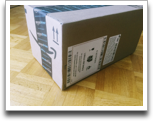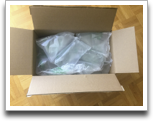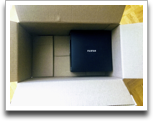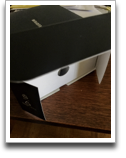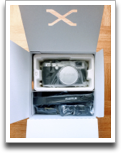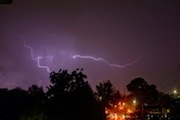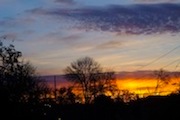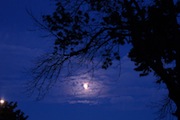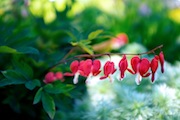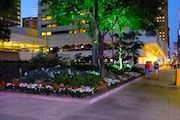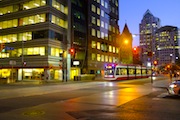I had only two requirements for the new camera: that it was lighter than the Canon 50D with a 24L lens, and have faster auto-focus than my nearly 5 year old X-E1. My love-affair with Fuji cameras continues with the X100F; this fourth iteration of the 100 series (the F stands for fourth) is the most enjoyable camera I have ever used.
X100 Series
When Fuji announced the very first Fuji X100 mirrorless camera in February 2011, I was ready to buy it— the compact size, the light weight, the retro look of the body, and the optical viewfinder with shooting information projected on it (a long overdue innovation) were all attractive aspects of the camera. However, after reading the early reviews I canceled my pre-order because the camera had shortcomings that I couldn't do without— the lack of a diopter adjustment and slow AF speed were the two biggest negative aspects.
I continued shooting with my Canon 50D with 24L lens until the Fuji X-E1 mirrorless, with better AF than the X100, was announced. The 50D was becoming too painful to carry daily and despite slow AF of the X-E1, the weight reduction was enough to convince me to buy it.
X100F Notable Specs
The X100F specifications listed below are only for the sake of completeness. They were not relevant when I was considering the camera:
- • 6K x 4K pixels sensor (24M pixels, 3:2 aspect ratio) with fixed 23mm (35mm equivalent) f/2 lens (with 50mm and 70mm digital zoom); mirrorless
- • Dials for shutter speed and ISO and aperture ring on the lens (to f/16) with multi-function zoom/focus ring on the lens (electronic)
- • Longer-life battery; can also be charged via USB
- • ACROS Film Simulation with Ye, R and G filters (not all models are capable of simulating this legendary film)
- • Joystick on rear can be used to move the focus-point and havigate menus
- • Built-in neutral density filter (for shooting wide-open on sunny days)
- • Optical viewfinder with diopter adjustment and superimposed shooting information; can be switched to an electronic viewfinder
- • Optical viewfinder with digital split screen and focus peaking to aid in focusing manually
- • Author and copyright information added to EXIF data can be edited directly on the camera.
- • WiFi transfer of images to another device (mobile phone or tablet) or wireless printer
- • Two optional teleconverter lenses are available.
Silver or Black?
The first decision I had to make was whether I would get the silver model or the black model? The original X100 only came in silver, the classic camera styling (cameras began to be painted black during the Apollo space program when the Hassleblads used by NASA were painted black).
The black model is more stealthy than the silver model and thus the preferred choice of the discreet street photographer. I am not a discreet person insofar as being a person of colour who takes photos, I do stand out in any crowd. So a silver camera announces, in no certain terms, that I'm not trying to hide that I'm taking your photograph.
What finally convinced me to choose the silver model was the appearance of the shutter button on my black X-E1; the paint had worn off the front portion of the button, revealing the bare metal underneath. The edges of the camera body which brused up against my coat also had visible wear points.
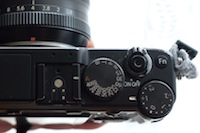
X-E1 paint-wear on the shutter button and body,
after 5 years of use, was enough to convince me
to choose the silver X100F.
Do I Buy it Now or Wait?
The second question I had to answer was whether to wait for an in depth review and decide or just go ahead and buy it based on the unanimously positive reviews I'd read so far. When I read a FujiRumours post that Fuji had extended the period before prices would be raised on certain Fuji products due to the differences in the Canadian dollar, I decided to wait no longer.
Add To Cart
I ordered the camera on Wednesday, May 3rd, 2017 at 10PM choosing regular free shipping. It cost $1920.99, including tax. The estimated delivery date was Wednesday, May 10th with a note that "A signature is required at delivery." I received shipping confirmation on Saturday, May 6th that camera had shipped via Canada Post. The camera was delivered on the promised date and was waiting for me when I got home that night.
Unboxing
I didn't open the package until the next morning and that was only to photograph the unboxing. The camera remained sealed in its plastic baggie and only the manual came out of the box.
The camera is packaged in a glossy black cardboard box printed with Fujifilm logo in white. The glossy ink had surface bruising no doubt inflicted during shipping. The flap on either side of the outer box can be opened to reveal an inner, white cardboard box with a finger hole used for extracting it. The white box has an "X" cut-out in the upper flap. When opened, the upper tier contains promotional brochures and manuals. The upper tier can be lifted out to reveal the lower tier containing the camera and accessories sealed in plastic bags.
I registered my camera with Fuji because they were running a contest for a monthly draw where the winner would get back the cost of the camera; the contest expired May 30th.
Dear Fuji, I Love You
"By beauty I mean that quality or those qualities in bodies,
by which they cause love, or some passion similar to it."
—Edmund Burke, On the Sublime and Beautiful
The day of the unboxing, I began by reading the manual before even unsealing the camera from its tamper-proof bag. I knew I was going to love this camera by page xi of the manual, titled Product Features (after a cursory glance at the product safety warnings). Fuji had added My Menu, a feature request in my Fuji X-E1 review.
As I continued reading, I was astonished by the number of useful features available and the amount of customization possible. For example, author and copyright information can be input directly from the camera and embedded into each photo; the 50D required the camera to be connected to a computer running the Canon's proprietary camera software.
A feature that I only imagined in a futuristic camera is available now: when shooting with the optical viewfinder with manual focus, the bottom right corner can display a zoomed-in version of the focus area to help in accurate focusing. Hilight peaking can be enabled on top of that— this is a perfect solution for photographers who wear glasses.
First Impressions
"Astonishment is the effect of the sublime in its highest degree;
the inferior effects are admiration, reverence, and respect."
—Edmund Burke, On the Sublime and Beautiful
When you hold the X100F, it feels like an Apple product.
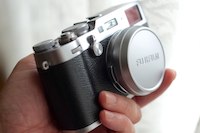
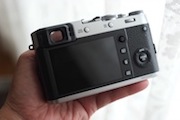
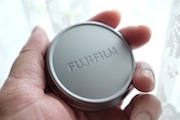
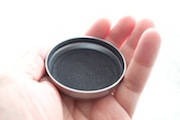
X100F, front and back, photographed with the X-E1; the lenscap, photographed with the X100F.
When you pick up the camera, it feels like its solidly built. It weighs 469g (16.5oz or approximately 1lb.) including battery and SD card. Holding the camera for long periods tires the hand. One side is heavier than the other; it would help if it was better balanced. Holding the camera by the grip and cupping your hand with the other hand against your body is more comfortable for long durations; the neck strap is a must. I am considering buying the premium leather case.
The lens cap is made of brushed (or sandblasted) aluminum, embossed with "Fujifilm" and has a black felt covering on the insides, to protect the front of the lens up to the multi-function focus/zoom ring.
This fourth iteration of the 100 series (the F designation stands for fourth) is quite probably the most perfect camera I have ever used. The X100F is a camera from the future, with features even I hadn't imagined possible. The camera's design is considered and thoughtful, optimized for the photographer's primary function— to take great pictures and enjoy doing it.
All the buttons on the rear of the camera were moved to the right of the LCD making it possible to access the buttons using only the right thumb. A new addition to the rear of the camera is the joystick. I would have preferred a spin-wheel of the Canon 50D but the joystick is acceptable. The front of the camera has a thumb-wheel under the shutter button, similar to the Canon 50D. Both the rear and front scroll-wheel and the directional buttons are multi-functional programmable buttons that can be customized to the user's preference.
First Photo
It should be a tradition for the first photo taken with your new camera be of your old camera.
I took the 32GB Sandisk SD card from my X-E1 and inserted it into the X100F and took some photos of the X-E1 to show the wear on the old camera.
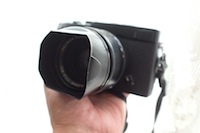
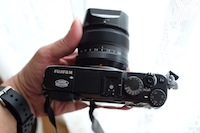
The first two photos taken with the X100F show my battered X-E1. (Left) The front of the lens hood is deformed because I dropped the camera from hip-height onto linoleum covered concrete; the camera and lens survived in perfect operational order, but I cannot unscrew the lens-hood from the lens. (Right) The top-view shows the paint wear on the shutter button and the body and the nearly disintegrated scratch-protector pad attached to the strap.
When you playback photos taken with a non-X100F camera, they are identified with a "gift" icon to indicate their foreign provenance.
X100F Battery & Charger
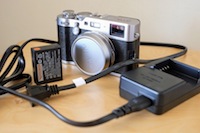
The X100F, NP-W126S battery and charger.
The X100F uses a NP-W126S battery (made by Panasonic). It is larger than the previous X100 batteries, but charges in the usual 150 minutes. The battery is now labeled with an orange dot which is used to orient it (match the orange tab) for insertion into the battery bay of the camera. This is a useful addition because I remember when I inserted the battery into the X-E1 for the first time, it was oriented incorrectly.
The X100F charger still has a wired plug rather than having a flip-prong like Canon. You can, however get a stub-plug to replace the wired plug. The only advantage of the flip-prong/stub-plug is that it is more compact when packing for travel.
X-E1 vs. X100F Auto Focus Speed
Updated: Thu Jun 8 19:34:40 2017 | Wed Jul 5 17:04:38 2017
The X-E1 is a camera with which I had a love-hate relationship— I loved the photographs it took (the 35mm f/1.4 lens had eye-searing sharpness; there was no need for post-processing image sharpening), but I hated the slow contrast-detect AF (it didn't help that I disabled the AF illuminator light).
The periodic X-E1 firmware updates did improve the AF speed, and I found a trick that by keeping the camera in macro mode, it sped-up AF by trying to focus up close first. Despite this, I photographed in Manual Focus mode and used the AE/AFL button to focus before taking the shot. This was fine for landscapes, but street photography with moving targets was a frustrating experience.

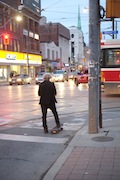
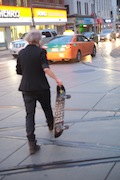
This sequence of images illustrates the missed focus of the X-E1 of moving subjects in low-light (7:20PM; the subject's dark clothes also don't help either). The middle image is pretty close to being in focus but the subject had stopped moving.
The X100F has hybrid AF with the centre portion of the sensor having both phase-detect and TTL contrast-detect, and the outer area surrounding the centre having contrast-detection only. This configuration should provide for a more enjoyable experience with fewer missed (out-of-focus) photographs.
In my preliminary tests of street photography of moving subjects, the AF performed admirably. Definitely better than the X-E1.


Panning shot of a rickshaw with the X100F in low-light (8:30PM EDT) and a speeding Vespa scooter; these shots would have been out-of-focus with the X-E1.
WiFi Photo Transfer and Camera Remote
Updated Thu Jun 29 15:58:22 2017
The X100F is capable of wirelessly transferring photos to an Android or iOS device running the Fuji Camera Remote App or a WiFi printer. The iOS app does not follow Apple HIG guidelines for app design and looks alien because of the proprietary toolkit being used; it also only operates in Portrait mode. From the App's Main Menu you can browse all the photos on the camera, you can push individual photos from the camera to the device or you can control the camera remotely.

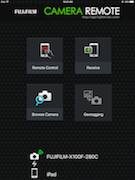
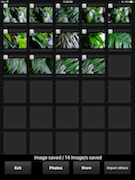
![]()
FujiRemote iOS App: The start-up connection screen, the home screen, the image browser screen (after image transfer is completed) and the WiFi Transfer screen on the X100F.
On the X100F, switch to Playback mode, press the MENU/OK button and select Wireless Communications; the camera will become a hotspot. Then, on your device, join the camera's WiFi network via Settings and start the Fuji Remote App.
The photos transferred wirelessly to my iPad are reduced in size (to either 1776x1184 or 1280x800?). I would prefer if the photos were either slightly higher in resolution (2048 pixels minimum) or had less compression because they look slightly "muddy" on my iPad Air.
The Camera Remote app is written using a proprietary library that does not follow Apple's Human Interface Guidelines. For a camera that feels like it was designed by Apple, this app is embarrassing to look at.
There is an annoying 3-second delay when selecting the very first image in the Camer Remote App's image browser. Subsequent image selections are responsive.
UPDATE Thu Jun 29 15:59:59 2017: I would really like to see an option to let me transfer "today's" or "most recent" photos with one click. I take an average of 50 photos every day and it's a burden to have to individually tap on each one every night.
Wifi Transfer Speed
Update: Mon Jun 5 18:01:00 2017
Last night, I timed (Clock/Timer app) the wireless transfer of 70 images from the camera to the iPad: 4 images (1 row in the image browser) took about 20 seconds (this will vary depending on size of the individual images in a particular row). All the 70 images took about four minutes.
Bulb Mode
In Bulb Mode, the camera keeps the shutter open for as long as the button is pressed (up to a 1hr maximum for the X100F). There happened to be a thunderstorm this week and I took the opportunity to try to photograph the lightning strikes (see Gallery). I set the focus switch to "MF", manually focused to infinity using the scale at the bottom of the display. I moved the shutter dial to "B", set the aperture to f/4 and ISO to 200 and set the camera on my windowsill. The first exposure I tried was for 13 seconds. When I released the shutter button after pressing it for 13 seconds, the rear LCD on the camera displayed a spinner with "Processing". It processed for about 13 seconds during which time I missed a really big strike!
So, I began to reduce the exposure time (10s, 8s, 6s) until I found that a 4 second exposure would not incur a processing delay. I continued making several 4-second exposures until one of them caught a lightning strike.
Silent Street Shooting
Mon Jun 5 18:01:00 2017
There is something charming about this camera that puts people at ease when you point it at them.
I took the camera out on the street on the evening of June 1. Despite being partly cloudy, the camera performed admirably. I was able to focus without any noticeable delay and shoot as fast as I could aim. I successfully photographed a couple of moving targets.
I two people smiled at me as I was photographing. In the 17 years I have been photographing, this never happened with the X-E1 and only once with the Canon 50D. There is something charming about this camera that puts people at ease when you point it at them.
The leaf shutter is barely audible when shooting with my face close to the camera body; I sometimes wondered if the photograph had actually been taken. I have switched-off the shutter sound (it can be customized to one of three sounds); there is also an electronic shutter which is completely silent.
Shooting with a Prime Lens
Tue Jun 6 18:09:17 2017
The X100F has a fixed (non-interchangeable) 23mm f/2 lens. You can digitally zoom to 50mm and 70mm using the multi-function ring or attach either a wide-angle tele-converter or a zoom teleconverter lens to the 23mm lens.
I prefer shooting street with a prime lens at a single focal length. I compose the shot in my mind before I take it and since I can't zoom in or out with the lens, I have to wait for the subject to walk into my composition before I take the photo. On the rare occasion, if I've missed a good shot, I will zoom with my feet— meaning I will run ahead, turn back and photograph the subject.
I find that having a zoom lens makes you waste time framing the shot in camera and possibly missing it. Not having a zoom means you have one less variable to fiddle with. I much prefer to get the shot and then frame it in post production by cropping.
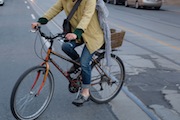
This cutoff portrait is the result of shooting with a prime lens for 5+ years and on the first day of shooting with the X100F (optical viewfinder and digital zoom) camera; I forgot to zoom out immediately after taking the previous photo.
Shooting like it's a Film Camera
Thu Jun 8 12:59:31 2017 | Updated: Tue Jun 27 15:20:03 2017
For the last few years, I have been pretending I have a film camera— 24 photographs per day (1 roll of film) and looking that the photographs only after a week or more has passed (to account for film processing time). This technique lets me look at compositions with a fresh eye and often times I wonder why I took a particular photograph; the photo looks quite mundane and I've forgotten the subject's interest.
Using the X-E1 for nearly five years I have settled on a configuration that produce perfect photographs anywhere: indoors, outdoors, in day and night. The electronic viewfinder displays a digital representation that clearly shows whether the scene is correctly exposed. Shooting with the optical viewfinder of the X100F brought a few surprises between what I saw and what the camera saw.
Yesterday, I did some street photography yesterday evening (7:30PM-830PM) using the optical viewfinder, metering set to Center-Weighted, Dynamic Range to 200 in Aperture Priority (varying the aperture from f/4 to f/8 depending on the situation) only to be surprised by some of the resulting photographs when I played them back at home.
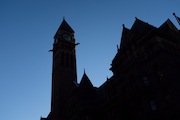
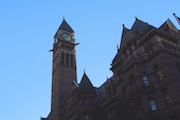
I was surprised at the underexposed image of the Old City Hall (that's not what my eye saw when I took the photo). I then performed shadow recovery of the underexposed photo using Google Photos editing tool.
The problem with the City Hall photo was that I focused on the clock tower and then re-composed the image so the center of the frame was the blue sky in he center. Since the metering was set to Center-Weighted, the camera exposed for the sky. I am used to shooting with the X-E1 using the AEL/AFL button to lock the focus and exposure before recomposing.
See the followup entry, Metering, for the best choice of metering mode ("Multi").
Street Photography
Mon Jun 12 18:04:31 2017 | Updated Wed Jun 14 14:48:17 2017
It was an extremely hot day today and I was hoping for some suitably dressed subjects; the streets of Toronto did not disappoint. I set the camera to f/8 and let it do the rest. For this photo, it picked ISO200 at 1/75s (1/60s being the minimum in the settings). 1/75s gave me a bit of blur in her moving hand, which I have to admit, I like.
I'm currently using single-point AF. I want to try Zone AF: "The camera focuses on the subject in the selected focus zone. Focus zones include multiple focus points (7x7, 5x5, or 3x3), making it easier to focus on subjects that are in motion."

X100F is a great street shooter. The single-point auto-focus is fast enough to focus on a subject walking towards the camera.
The camera grip did get a bit warm (which is normal according to the manual; the camera does display a temperature warning if it becomes too hot) during the 40 minutes I was photographing. I used to shoot the X-E1 with 1 minute power-save and the camera went into powersave at the most in-opportune times— sometimes, just as I was raising the camera to my eye, it would go to sleep. so the X100F power-save is set to 2 minutes. So far, I have not had the camera enter power save at inopportune times.
Upgraded Firmware
Tue Jun 12 18:20:00 2017
Upgraded the camera Firmware to 1.01. Everything seems to be working fine. The new firmware fixed the following:
- • The phenomenon is fixed that ISO cannot be changed by the command dial when ISO is set to AUTO by Camera Remote via WiFi connection to a smartphone or a tablet.
- • When a camera turns on in MF mode, the focus position comes to the original position where a camera turned off.
- • The phenomenon is fixed that in MF mode, a focus can shift in a specified condition (ex. repeated CL shooting).
- • Improvement of operability for the command dials.
This is the procedure to upgrade the firmware.
Face Detection (Oops!)
Tue Jun 13 16:30:30 2017
Look in thy glass, and tell the face thou viewest
Now is the time that face should form another;
—W. Shakespeare, Sonnet III.
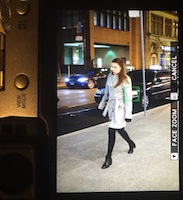
The X100F's face-detection in Playback mode can be amusing at times.
Note that the displayed photo was taken with the X-E1.
ACROS Film Simulation
Wed Jun 14 14:52:59 2017
"ACROS Film Simulation: Take black-and-white photos with rich gradation and outstanding sharpness. Available with yellow (Ye), red (R), and green (G) filters. Filters deepen shades of gray corresponding to hues complementary to the selected color. The yellow (Ye) filter deepens purples and blues and the red (R) filter blues and greens. The green (G) filter deepens reds and browns, including skin tones, making it a good choice for portraits."
Metering (aka Photometry)
Tue Jun 27 15:16:27 2017
The X100F has four metering modes: Multi(point), Center Weighted, Spot, Average. The Photometry Menu (Fuji's term for "metering") is programmed on Fn1 button next to the shutter release.
If your scene contains both bright sunlight and shadows, the "Multi" metering mode (with Dynamic Range set either to Auto or to your preferred setting of 100/200/400) is the most accurate for correctly exposing the scene so you don't blow the hilights and lose the shadows.
The X100F camera is smarter and more capable than my manual skills and I have to really try hard to take bad pictures with it. Even if I screw-up completely and under-expose the scene, the shadow-recovery in post-processing is exceptional.
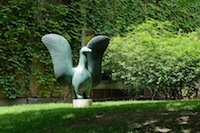
Spring Bird: Both shadows and hilights are perfectly exposed
with metering set to Multi and Dynamic Range set to Auto.
White Balance
Wed Jun 28 15:38:32 2017
I have White Balance set to Auto because 99% of the time it is correct. Flourescent lighting throws off the White Balance in every camera I have ever used. I recently ducked-into St. Michael's Cathedral during a brief rainstorm and took the opportunity to photograph it after the recent extensive renovation.
I happened to check a photograph after taking it and noticed that the White Balance was off. The lighting it actually a bit yellowish; the closest preset was "FL1". You can shift the White Balance via a Colour Grid, using the joystick, by selecting the Auto WB menu item.
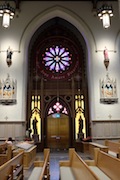
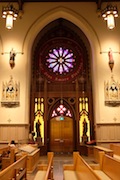
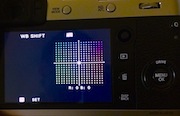
Photo 2, on the left, shows the X100F's chosen White Balance
while Photo 2, middle, shows (close to) the actual White Balance. The photo on the right is the WB Shift color grid.
Film Simulation Bracketing
Tue Jul 4 13:51:26 2017
One of the available Drive modes (Film Simulation Bracketing) allows you to simulate three different types of films for each photo taken. I decided on Velvia, ACROS-Green and ACROS-Red. I created a Google Photos album of my first experiment.
This techinique will hopefully help me to see the world in black and white before I take the photograph.
| Samples of Film Simulation Bracketing experiment. | ||
 Velvia |
 ACROS Green |
 ACROS Red |
 Velvia |
 ACROS-Green |
 ACROS-Red |
1, 2, 4, 8, 15, 30, 60, 125, 250, 500, 1000, 2000, 4000
Tue Jul 18 14:31:27 2017
I noticed that the shutter-speeds on the dial on the X100F has a quirky progression; the series starts off predictably, dubling every step) and then diverges in two spots: from 8 to 15 instead of 16, from 60 to 125, instead of 120.
Since the X100F is inspired by the vintage Leica cameras, I decided to look at Leica shutter dials and noticed that Leica cameras have the identical quirky progression.
Next, I entered the sequence into the The On-Line Encyclopedia of Integer Sequences with no results.
After some more searching, I came across a photo.net forum posting linking to another (archived) webpage that explains the quirkiness. One explanation is that it's specifically related to leaf shutters and it makes ISO/shutter/aperture calculations easier.
Update Thu Jul 27 15:18:22 2017: David sent me a link to a Stackexchange post that attempts to explain the quirkiness.
Battery usage and power saving
Thu Jul 27 15:21:06 2017
I charge the X100F battery every two days with typically 20% charge remaining before recharging. My daily usage is typically three (occasionally four) half-hour periods of photography.
The camera goes to sleep (power-save) if it's idle for 2 minutes (i'm considering increasing this to 3 minutes). I typically wake it up a few moments after it has entered power-save because (it requires a two-second press to wake it up) on several occasions shooting Street, the camera was still in the process of waking up when I had raised it up to my eye and was ready to shoot.
In comparison, the Canon 50D was ready to shoot by the time I had raised it from my hip to my face.
I typically shoot in Aperture Priority (f/8 on sunny days, f/5.6 on overcast, and f/2 at night), shutter is set at 1/125s and ISO is calculated by the camera up to a max of 6400).
Teleconverter Lenses
Tue Aug 1 15:07:41 2017
Dan Carr has a review of the Fuji wide and normal teleconverter lenses.
I was interested in the 50mm teleconverter but after seeing it, I would have to agree that it's "comically large" and I can't imagine mounting that on my camera (the reason for the size is that the lens maintains the f/2 aperture rather than the typical loss of 1-stop).
I would have preferred to see something physically smaller. Also, a f4 or f/5.6, 90 or 100mm equivalent lens for outdoor sports?
"The Invisible Guest"
Tue Aug 8 18:35:03 2017
A Fuji X100 is briefly featured in the Spanish crime thriller "The Invisible Guest" (Contratiempo). I have included a couple of screenshots from the movie, below.


A Fuji X100T(?) in the movie "The Invisible Guest". The rear of the camera reveals
the column of buttons on the left of the rear LCD, so it's definitely not the X100F.
2017 Partial Solar Eclipse
Mon Aug 21 17:40:19 2017
With blinding stars in their eyes but all they saw was black
—"Black", Danger Mouse.
I used a pair of eclipse glasses to shield the lens and took photos of the first half of the eclipse. The album also has an animation of the entire photo set.
I used Mr. Eclipse's suggestions for photographing the eclipse: ISO 200, f/8 at 1/125s at the start and the 1/60s at the peak. Lens was manually focused to infinity, and I used the LCD display in the viewfinder.
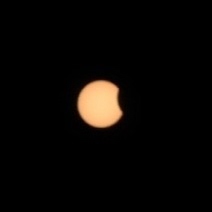
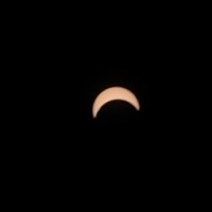
The start and peak of the 2017 solar eclipse seen from Toronto.
Digital Zoom Disabled in Some Modes
Fri Sep 8 15:38:28 2017
The digital zoom is disabled when the Drive Mode is set to High-speed. I only realized that when I tried zooming just after switching drive modes. For the longest time I didn't know why zoom would suddenly stop working.
I would be nice if the drive-mode icon blinked in red whenever the photographer tried zooming in modes where it's disabled.
"Pink Eye"
Thu Nov 9 13:55:05 2017
This morning, on my way to work, I decided to photograph a Rememberance Day display. I took the photo and I looked at it in playback. IT WAS TINTED PINK!!!!! My first thought was that one of the sensor-filters shook loose and I was going to have to send the camera in for repair.
The live image on the LCD was tinted pink and viewing the digital through the viewfinder was also pink. While walking to the train station, I decided to try a few things to see if I could fix the problem– I performed a full reset– no change; removed the battery and restarted the camera– no change.
Then i occured to me that when I brought up the menu, the screen wasn't tinted pink. Switching the Shooting Style to Monochrome, ACROS or Sepia wasn't tinted pink either.
For the rest of the morning, until I got to work, I shot in ACROS-G.
After I arrived at work I searched "X100F pink images" and voil´: "Red/pink tones on LCD display". It was a simple case of the White Balance setting being shifted to Red via the WB Shift menu. This probably happened last night when I put the camera in my jacket pocket without switching it off and the rear buttons bounced around against my thigh.
Phew!
X100F V.2.00 Firmware
Thu Dec 21 18:29:58 2017
Firmware update version 2.00 was released for the X100F
- Support for backup/restore of camera settings via FUJIFILM X Acquire: Once connecting a camera to a computer via USB cable, the "FUJIFILM X Acquire" allows users to backup/restore camera settings to/from a file. Copying all camera settings from one camera to another is available. Settings other than date, custom white balance, custom registration/edit can be backup and restored. FUJIFILM X Acquire Ver.1.7 Installer can be downloaded from our website.
- Support "FUJIFILM X RAW STUDIO"(Macintosh). Once connecting a camera to a computer via USB cable, the "FUJIFILM X RAW STUDIO" enables users to convert RAW files with X Processor Pro. The first batch processing will also be available. The "FUJIFILM X RAW STUDIO" can be downloaded from the FUJIFILM website for free.
- Improve radio flash controller usability. The upgrade allows users to shoot with compatible third party studio flash in high speed sync. or TTL mode via their radio controllers.
- Support for "Instax SHARE SP-3". Additionally, "Instax SHERE SP-3" has become compatible with this camera.
- OFF is added to the function allocation of the CONTROL RING SETTING
- Focus point can be chosen when zooming in for precise focus. When zooming in for precise focus, you can choose the focus point by using the focus stick (focus lever).
"Cordless" Charger
Wed Jul 11 20:12:47 2018
Whilst watching a Youtube video review I found out that the two-pronged plug from the Apple Macbook power charger brick, fits the Fuji battery charger. So if you don't like the long power cord on the charger, you can swap it out and replace it with a flip-plug.
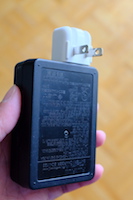
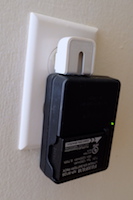
Apple flip-plug on Fuji battery charger
X100V Announced
Wed Feb 5 18:37:32 2020
Fuji announced the fifth generation model in the X100 premium compact camera line: the X100V (V represents 5 in Roman numerals). Main features include a rear tilt-screen, weather sealing (a must-have in my request list below), new lens design.
The easiest way to distinguish the 100F from the 100V from the front is the position of the OVF/EVF toggle switch (it's placed entirely in the metal part of the camera on the V) and the line along the top part of the camera which is uniform on the V and two different heights on the F.
Will I buy the 100V? Not at this time; I'm quite happy with the 100F. My next camera will be likely be the Fuji XT4.
X100F EOL
Mon Nov 30 18:52:50 2020
The Fuji X100F was end-of-lined November 2020; BHPhoto was selling it for $899.
Like a Leica?
Mon Feb 8 18:19:45 2021
I decided not to get the XT4. One review described it as an excellent video camera and a very good photography camera; I want an excellent photography camera. I recently read and interesting proposal– an X100 with interchangeable lenses. I find that quite interesting. Yes, I can attach two other lenses (28mm & 50mm) to the X100 with a teleconverter, but that's not the same as being able to attach all XF lens (like the razor sharp 35mm that's on the XE-1).
I think the next generation of the X100 would be interesting if the lens was interchangeable and I would most definitely buy a Leica-like Fuji camera.
Fuji X100VI
Sun Feb 18 09:13:30 2024
The reveal of the Fuji X100VI (successor to the X100V) is imminent (February 22, 2024. UPDATE: it was announced on Feb. 20). FujiRumors has confirmed the following:
- 40MP X-Trans V sensor (increased from 26MP)
- IBIS (in-body image stabilization)
- Same 23mm lens (can be weather-sealed with filter and adapter)
- Body will be 1mm taller
- New Reala Ace film simulation
I'm sure the camera will be great and will continue to be popular but it doesn't excite me personally.
I have been thinking of switching to film photography in recent days as there is nothing more to discover in digital photography, but then it occured to me: what if Fujifilm started making APS-C film cameras?
X100F Suggestions for Improvement (Must-Haves)
- Weather sealing: I love to shoot in all kinds of weather. I'll gladly pay more money for this.
- Drive Menu: Add Intervalometer to the Drive Menu. It's buried somewhere in the Shooting Menu.
- Paper Manual: The body text should be printed in a darker font; I find it difficult to read the light grey text. The camera anatomy pages ("Parts of the Camera") should use a larger font for the enumerated list, listed in two columns instead of three.
- Gridline Display: The rule of thirds grid should shrink proportionally with the frame when zooming with the Optical Viewfinder when using the Multi-Function Ring. It throws-off my composition when I use digital zoom; I feel helpless composing without the grid.
- Transferred Images: JPEGs transferred via WiFi look a bit muddy (over compressed) on an iPad Air screen. It would be nice to see slightly better quality images (lower compression) and/or higher resolution (2048 pixels at minimum).
- Camera Remote (iOS app): Fix the extremely annoying 3-second delay when selecting the very first image in the Camera Remote App's image browser.
- Camera Remote (iOS app): Choose "Most Recent" (new) photos with one tap, instead of tapping on each photo, before transferring.
- Power Save: Faster wakeup from powersave. It currently take a long press of the shutter button (perhaps 2s) before the camera is ready to shoot (Thu Jul 27 19:44:22 2017).
- Q Menu: Allow access to the Q menu in Playback mode. It's only available when the camera is in Shooting mode.
- Fn Buttons: Allow Movie Mode (recording) to be assigned to one of the five function buttons. I could do it on the X-E1 but it's not possible with the X100F. It's available in the Drive menu and I've added it to My Menu as shortcut.
- My Menu (1): Allow press-and-hold MENU/OK to open/edit My Menu. (I can press and hold the Q button to edit the Q menu, so logically...)
- My Menu (2): My Menu is inaccessible if there are no entires present. It would be better if it was always active with a menu item (or button) that allows the addition of menu items. It's non-obvious (without reading the manual) that My Menu has to be edited via User Settings.
- Joystick: Allow a sub-menu item (usually selected by scroll-right) to also be selectable by clicking (depressing) the joystick. The right-arrow indicating a lower-level menu is too small that I click on the joystick and wonder if the joystick has stopped working, then try again, only to notice the tiny arrow at the right.
- Focus Ring: In single-shot AF mode with the optical viewfinder, rotating the focus ring with the shutter button half-pressed should adjust the focus (if the shutter button is released, the focus ring should go back to adjusting zoom)
- WiFi: Add a mode to automatically backup reduced size photos from the camera to a nearby registered mobile device via wifi whenever the camera is idle. Photography should take precedence on demand; the transfer should abort if the camera is needed for photography.
- Battery: Plug-stub instead of wired plug. I realize this is a Panasonic battery and charger and not part of the camera, but it is part of the overall experience.
- Fuji Remote App: Redesign the iOS App following Apple's HIG and to work in both Landscape and Portrait modes.
